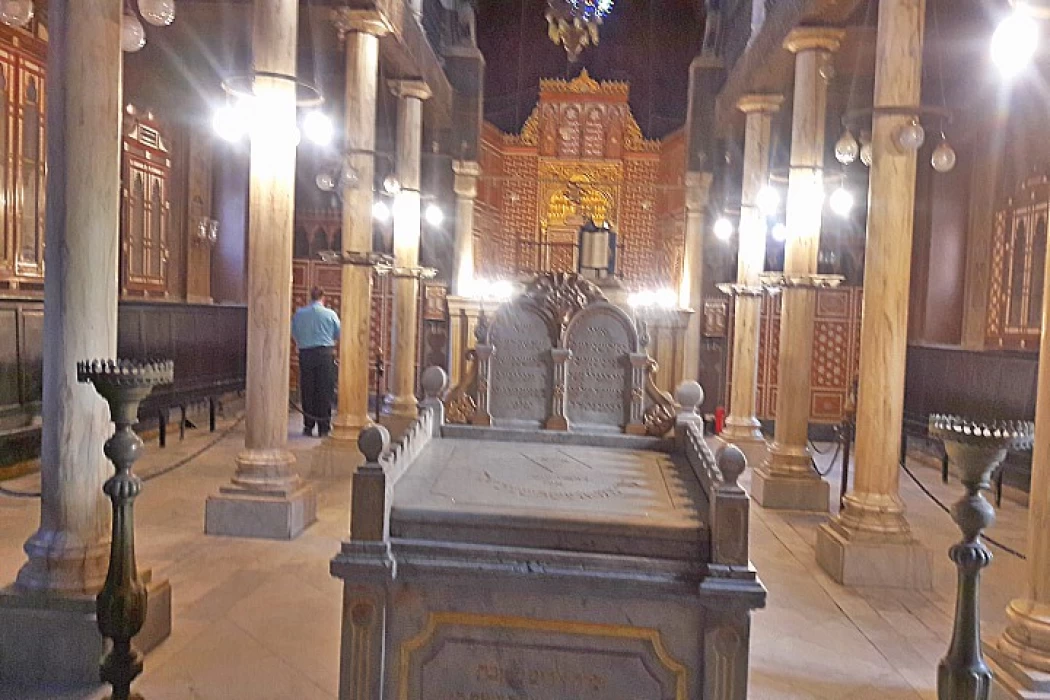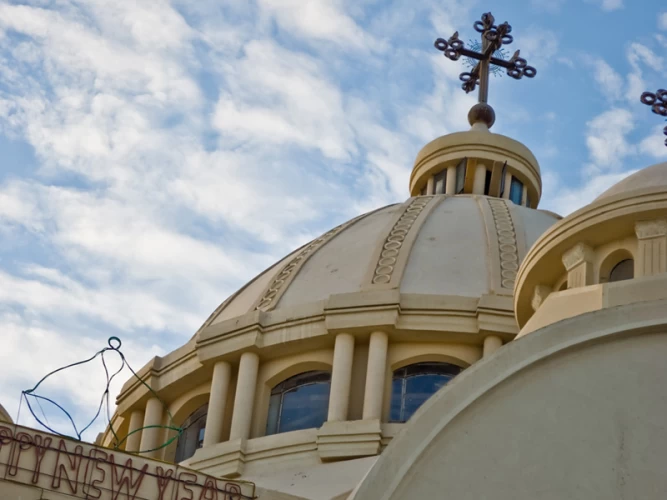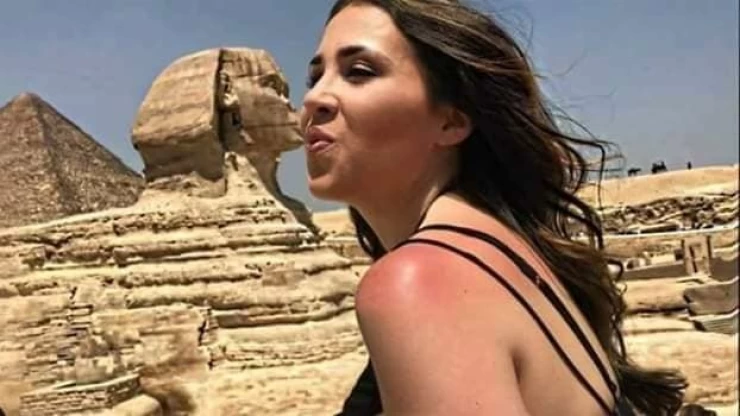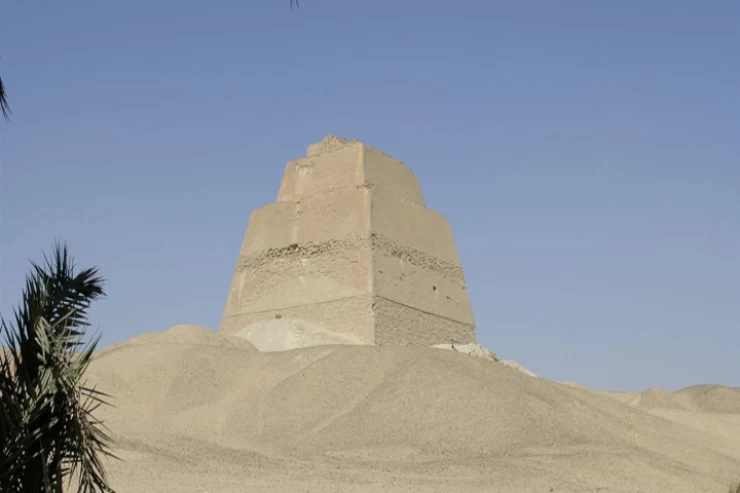
Ben Ezra Synagogue
The Ben Ezra Synagogue is one of the Egyptian Jewish synagogues. It is located in the Fustat area (ancient Egypt district). It is one of the largest and most important, especially with the Egyptian government taking care of it and restoring it, turning it into a tourist monument and shrine. His library contains precious books and Jewish periodicals that chronicle the existence of the Jewish community in Egypt.
The temple was originally a church called the " Church of the hangers - "and the Orthodox Church sold it to the Jewish community when it went through financial hardship as a result of the increase in taxes imposed on it at the time, and the temple was named after Ezra the writer, one of the evacuated rabbis of the Jews, and is sometimes called the temple of the Palestinians, or the temple of the Levites. Modern scholars and Jews know it as the "temple of Geniza" after the famous Geniza collection of documents found there in 1890.
The temple is the oldest of the temples of Cairo. Jewish stories tell that Moses had chosen a place to pray next to the Nile in what was later known as Fustat, but according to Al-maqrizi, the temple was originally a Christian Church, and was sold at some time to the Jews, based on the news of a church named St. Michael in the same spot, and there is no trace of it today, sources indicate that it was sold in 882 ad to the Jews in order to collect some amount of money, which was imposed by Ahmed Ibn Tulun on Christians. At that time, "Abraham ibn Ezra" paid an amount of 20,000 dinars. It is dated that the temple was rebuilt again, and the condition of the building worsened so much that the sect decided to demolish it completely and build it again in 1890. And its conditions worsened again, until the Egyptian government renovated it jointly with the Canadian Center for architecture in 1991, and it became a well-known tourist shrine.
The Jews narrate that this spot is a place that Moses had used to pray after the plague struck the country according to the well-known story. Other stories tell that the Prophet Elijah (Eliyahu) had manifested to the worshippers there more than once, and that the temple contains the remains of the prophet Jeremiah, as well as the story of the ancient Tanakh manuscript, now known as the Aleppo Codex, written by the Masorti Moshe ben Asher, his son Aharon Ben Asher from the Karaite Jewish community and punctuated it to be pronounced correctly without distortion and somehow transferred to the Jewish community of Aleppo Levant, it is said that this copy is the one by which the current copies of the Tanakh were adjusted and revised.
The temple has been used throughout history by the majority of Jewish communities in Egypt, so it was used by Iraqi Jews, namely Karaite Jews, shame Jews, Ashkenazim, and Sephardim. It ended up as a temple for Rabbinic Jews after the Karaite Jewish community moved to Cairo Al-Mu'izz in the Fatimid era. Rabbinic Jews speak Arabic as their native language.
A Geniza is a collection of papers and documents that may not be destroyed or neglected according to the Jewish religion, especially if it includes the name of God among its folds, but it is stored in an isolated room in the synagogue or temple for generations, and derived from this word the word funeral in Arabic, meaning burial or burial. Because after each term these documents must be collected and buried in cemeteries. A collection of extremely rare documents was found in this temple, from which it is possible to date the living conditions of Jews for many centuries, and the conditions of their society as a whole.
The temple consists of two floors, like a large number of synagogues and Jewish forums, the first is used for male worshippers and the second for women's prayer, the temple receives Jerusalem, and contains two rows of marble columns with magnificent crowns, and is divided into three sections, the largest of them is the middle one, which is topped (shakhshikha) or the lighting and ventilation hole in the middle of the preaching platform and around the seats of worshipers, and the temple on the eastern side, contains the ark of the Covenant and Torah scrolls. There is still a great demand to visit the temple from various tourists of the world, regardless of their religions and orientations, because of its aesthetic and historical value.
In the Old City of Cairo, the Ben Ezra synagogue is perhaps the most famous Jewish house of worship in Egypt and an important historical monument. Again, Coptic Cairo is near not only expelled slums but also works of art such as the Hanging Church of the Virgin Mary and the Coptic Museum. And over the years they have made it nice to the Ministry of Tourism and Antiquities of Egypt, who restored the synagogue several times already. Nowadays, it is still one of the places included in a day tour in Cairo, accessible to local and foreign tourists interested in its historical background.
Moreover, one of the most important elements of the Ben Ezra Synagogue is the Cairo Genizah, which offers the life history of the Jews in Egypt for the past 850 years in the form of a very rare collection of records. These records, which comprise the Genizah, house precious archival material on the history of the community’s daily life, its trade, religion, and mild manuscripts like family pictures and court documents. This raw material has been made accessible by various scholars in the course of research in numerous libraries all over the world, making good research on the Jewish civilization. Together with the historical materials, the Genizah became an object of interest for many historians and tourists, thus enhancing the image of the synagogue as one of the obligatory places to visit in Coptic Cairo.
The word “synagogue,” which refers to a house of worship, education, or gathering, is derived from the Greek language, where it means mingling’ or ‘coming together’. The significance of the Ben Ezra Synagogue, both in history and spirituality, is linked to its central position in Old Cairo to the Nile River. This, however, goes by most of the traditions, being the very location where the Pharaoh’s daughter was said to have found the little Moses, who was set adrift in a small boat down the river. It is this sacred bond that enhances the beauty of the synagogue, incorporating its history with the tales from the Torah and the Christian Bible as well.
The name "Ben Ezra"
The synagogue is named after the Jewish scholar and philosopher, Abraham Ben Ezra, who purchased the property in 882 AD. At the time, it is said to have originally been a Coptic church that was sold to raise funds required by the ruler, Ahmad Ibn Tulun. After its acquisition by Ben Ezra, it was converted into a synagogue, and over the centuries, it has become a prominent place of Jewish worship and learning. For visitors exploring Cairo, the Ben Ezra Synagogue offers a unique opportunity to connect with an often-overlooked aspect of Egypt’s diverse religious landscape.
The existing edifice of the Ben Ezra Synagogue was constructed in 1892 as a result of the preceding structure caving in. Its architecture is of the basilica pattern, which has a rectangular shape and two levels with a sectioning for ladies and gentlemen. The interior space of the synagogue is well known for its detailed and elaborate carpets, exquisite wooden doors, and marble tiles, all combining unique Jewish and Middle Eastern arts. The traditional Jewish laws state that within any synagogue, the Torah ark is Eastern facing, and the beautifully carved eternal abode of the scrolls of Torah, gazes East, more so Jerusalem.
An interesting and perhaps surprising feature of the synagogue is the rich carvings that cover the surfaces of the walls in almost all the rooms and that draw beautiful floral and geometric designs. Some Kudine robots were stored at the Jewish Community Center since renovation works were carried out in the 19th century, which also shed opened indiscriminately in the South African communities, where so-called Genizah’s of the Turkish Synagogue preserved natural historical monuments, especially such sacred temples.
A Window into Egypt's Diverse Religious Heritage
Exploring the Ben Ezra Synagogue not only helps in understanding two aspects of the Jewish culture in Egypt but also the attitude towards the places of worship in Egypt towards keeping them intact. As the temples of Luxor and Aswan, this synagogue is an example of how the country can protect its religious and cultural pluralism. The synagogue is silent yet articulate at the same time, an embodiment of the significant presence of the Jews in Egypt over the centuries, and as such holds importance for people wishing to explore the rich and diverse history of the country.


















